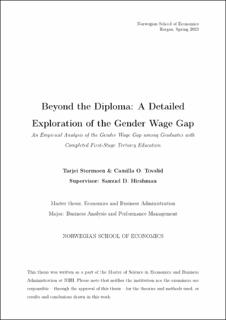Beyond the Diploma : A Detailed Exploration of the Gender Wage Gap : An Empirical Analysis of the Gender Wage Gap among Graduates with Completed First-Stage Tertiary Education
Master thesis
Permanent lenke
https://hdl.handle.net/11250/3090219Utgivelsesdato
2023Metadata
Vis full innførselSamlinger
- Master Thesis [4372]
Sammendrag
A gender wage gap has been thoroughly documented, both in Norway and internationally.
Prior studies have substantiated a significant wage discrepancy between genders among
those holding an MBA, yet comprehensive research into this disparity across other graduatelevel
disciplines remains scarce. The purpose of this thesis is to fill this gap, by examining
the wage gap, not only among business graduates, but also among medicine, law, and
STEM graduates. To examine the gender wage gap in these four educational groups, we
utilize cross-sectional register data from 2019, obtained from Microdata.no. Using recent
high-quality data enables us to determine the severity of the graduate-level wage gap, and
allows for an exploration of potential disparities between different educational groups.
Our analysis reveals a significant wage gap among graduate-level workers with educational
backgrounds in medicine, law, STEM, and business fields. In this combined sample of
graduate-level workers, we identified a raw wage gap of 15.39% and an adjusted wage gap
of 7.98%. In comparison, the unadjusted wage gap in the general working population in
Norway stood at 12.4% in 2019. Thus, our results suggest that the wage gap might be
larger among those with a graduate-level degree than in the general working population.
We also uncover considerable gender wage gaps within the four educational groups.
Moreover, our analysis reveals that the wage gap is substantially smaller among part-time
workers than full-time workers. Additionally, we found that men enter the labor market
with significantly higher wages than women, and that they have a significantly higher
return on experience. At last, we found that the gender wage gap, at large, is greater
among graduate-level workers than among undergraduate-level workers.
In this study, we confirm the existence of a wage gap between men and women at the
graduate level in Norway. To successfully close the wage gap, we suggest several measures.
First, additional research should be conducted to understand why men experience a higher
return on experience. Moreover, we recommend initiatives to encourage more women to
pursue full-time positions. The promotion of efforts to support and encourage women into
senior roles, where compensation tends to be higher, could also contribute to narrowing
the wage gap. Lastly, altering workplace structures and shifting societal expectations
might further reduce segregation in the workforce.
